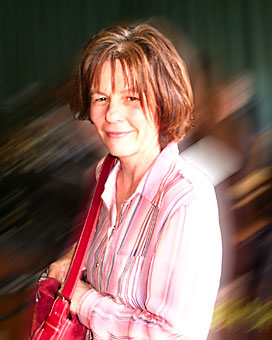 |
|
Photo courtesy of Nancy Barron
|
Author Ann Cummins will give a free reading of some of her work tonight, at 8, in the Modern Languages auditorium.
|
|
|
By Kylee Dawson
Arizona Daily Wildcat
Wednesday, April 21, 2004
Print this
╬Red Ant House' author to speak at UA tonight
It's not easy for most writers to get their work printed in magazines like McSweeney's and The New Yorker. Ann Cummins, a writer and professor, grew up Irish Catholic on a Navajo reservation, a child of working-class parents. It's in sharp contrast to the decidedly more suburban, bourgeois upbringing of most writers who publish in those institutions of modern short fiction. Tonight, she'll read some of her work tonight as part of the UA Visiting Prose Writers Series.
Cummins, a former UA student whose work has been published in other periodicals like Antioch Review and Quarterly West, is an adjunct creative writing professor at Northern Arizona University. Her unique childhood greatly contributed to her stories, which feature the lives of the working class.
Cummins was born in Durango, Colo., but moved to a Navajo reservation in Shiprock, N.M., when she was 9 because the uranium mill her father worked for was relocated to the reservation. Cummins attributes much of her writing style and characters to her upbringing.
"I would think a lot (of inspiration) just comes from coming from a big Irish Catholic, working class family," she said. "So the basic dramas and things like that automatically grow in a working class situation are also well-formulated for me as a writer.
"My mother's a wonderful storyteller, and my father was kind of a silent, old-school Irish guy. But he used to sing all the time, so I got the sense of rhythms of language from my family who sang together."
The Navajo culture has somewhat influenced Cummins' writing as well.
"The Navajo culture is something very interesting to me to go back to and try to look at the subtle dramas that occur between cultures, but I learned to tell stories from my own family," she said.
 |
|
I think my characters are average, but what's interesting to me are their quirks. ¸ Ann Cummins, author, UA alumna
|
 |
Though 90 percent of the reservation population was Navajo, Cummins said she went to school with people of other ethnicities and had both white and Navajo friends growing up.
"We were there in the late '60s, and it was an odd place to be at the time," she said. "It was very much structured like an apartheid country where the majority was not in control. I had lots of Navajo friends, but there was a whole story that wasn't being told while I was a student there. Things changed in the '70s when the American Indian Movement moved in."
Cummins said that some students were punished by teachers and principals for speaking Navajo in class.
"There was a systematic effort by the government that started in the '20s to undermine the Native American cultures, and that included instilling the English language on the reservations," she said. "So basically, Navajo was not taught and actively discouraged. That, again, all changed in the '70s, when Indian people began getting college degrees and getting back into the education system. (In the) '70s, ╬80s and '90s, history classes were taught differently. The native languages were taught."
Cummins admits that, as a white girl, she may have personally experienced racism or discrimination while living on the reservation. But she said, "It was very subtle. For the most part, I just had a happy childhood there."
After graduating high school in the 1980s, Cummins attended the UA, where she said she had a lot of fun studying in the workshops and is still in touch with many of her colleagues.
"We had a great community there of writers," she said.
Cummins admits she did not start writing until she was in her late 20s. But when she had several stories published by various magazines and journals, she decided to go to graduate school and become a creative writing instructor at the suggestion of her friends.
Cummins typically writes stories that surround the wild characteristics of "working-class characters," most of whom come from her subconscious.
"I don't think there is an average character," Cummins said. "We all have wild elements in us. And just the notion of the unconscious or the subconscious introduces the wild, the uncivilized, the part of us that is sort of trying to find expression through the creative. So I think my characters are average, but what's interesting to me are their quirks.
"I make a study of people, too, so my characters might be a hybrid of the memory of the way one person talks or one person looks or something like that. I don't call on actual, real people," she said.
Cummins divides her time between her part-time teaching position at NAU and Oakland, Calif., where her husband, musician S. E. Williams, resides.
"I guess maybe I'm so much schizophrenic by nature," Cummins said about her love for traveling, something she enjoys doing when she's not writing.
"Red Ant House," Cummins' first book of short stories, was published last April. She will give a free reading of the stories published in McSweeney's in the Modern Languages auditorium at 8 p.m.

